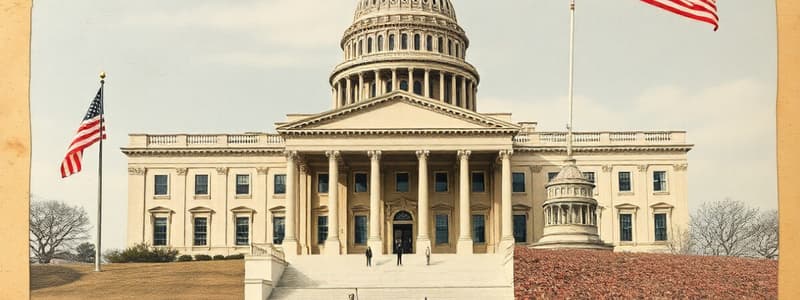Podcast
Questions and Answers
Which principle of the U.S. Constitution is most directly reflected when citizens participate in electing their representatives?
Which principle of the U.S. Constitution is most directly reflected when citizens participate in electing their representatives?
- Limited government
- Separation of powers
- Federalism
- Popular sovereignty (correct)
The division of power between the federal government and state governments is best described as which constitutional principle?
The division of power between the federal government and state governments is best described as which constitutional principle?
- Republicanism
- Checks and balances
- Separation of powers
- Federalism (correct)
Why did the Framers consider it essential to establish a limited government?
Why did the Framers consider it essential to establish a limited government?
- To ensure the federal government could effectively regulate interstate commerce.
- To protect individual rights and prevent governmental overreach. (correct)
- To prevent any single branch from becoming too powerful.
- To promote national unity by standardizing laws across all states.
Which of the following is an example of a power reserved to the states?
Which of the following is an example of a power reserved to the states?
The system of checks and balances is designed to prevent:
The system of checks and balances is designed to prevent:
Which of these is the best example of concurrent powers?
Which of these is the best example of concurrent powers?
If the President vetoes a bill passed by Congress, this is an example of:
If the President vetoes a bill passed by Congress, this is an example of:
In a republican form of government, how do citizens exercise their power?
In a republican form of government, how do citizens exercise their power?
Flashcards
Popular Sovereignty
Popular Sovereignty
Government legitimacy comes from the people.
Republican Government
Republican Government
Citizens rule through elected representatives.
Limited Government
Limited Government
Government powers are strictly defined and limited.
Federalism
Federalism
Signup and view all the flashcards
Federal Powers
Federal Powers
Signup and view all the flashcards
State (Reserved) Powers
State (Reserved) Powers
Signup and view all the flashcards
Concurrent Powers
Concurrent Powers
Signup and view all the flashcards
Separation of Powers
Separation of Powers
Signup and view all the flashcards
Study Notes
- The United States Constitution offers a solution to governmental challenges based on seven key principles.
Popular Sovereignty
- Leaders and government originate from the consent of the people, establishing them as the source of political legitimacy.
- The Preamble clarifies that the power resides with the people of the United States, who establish the government for their well-being.
Republican Government
- Citizens actively participate in governmental affairs.
- The government is not headed by a hereditary ruler like a king.
- Elected representatives make laws and govern on behalf of the people.
Limited Government
- Framers aimed to avoid governments that infringe on rights or favor groups.
- Focus was placed on establishing a strong, but limited government with strictly defined powers.
- Powers are specifically given to it by the people.
Federalism
- The U.S. operates under federalism, where power is shared between state and federal governments.
- The Congress can coin money, regulate interstate and foreign trade, maintain armed forces, and create federal courts.
- States cannot exercise these powers.
- The Constitution reserves all other powers to the states, known as "reserved powers," found in the Tenth Amendment.
- Reserved powers include passing marriage and divorce laws, regulating trade within a state, and establishing schools.
- Concurrent Powers are shared by the state and federal governments, including raising taxes, borrowing money, providing for public welfare, and carrying out criminal justice.
Separation of Powers
- Divides legislative, executive, and judicial functions among separate, independent bodies.
- Limits potential for arbitrary excesses by government, as all three branches must sanction laws.
Checks and Balances
- Each branch of government can check or limit the power of the other branches.
Individual Rights
- Needed for each person to pursue their lives and goals without interference.
- Rights include:
- The right to life.
- The right to liberty.
- The right to the pursuit of happiness.
- The right to property.
- The right to freedom of action.
Amending the Constitution
- Formal proposal of an amendment is the first step.
- Congress can propose an amendment with a two-thirds vote.
- Two-thirds of state legislatures can call a convention to propose an amendment (this method has not been used).
- Ratification, the second step, requires approval by three-fourths of the states.
- States can ratify an amendment via a state convention or through a vote by the state legislature.
Studying That Suits You
Use AI to generate personalized quizzes and flashcards to suit your learning preferences.




